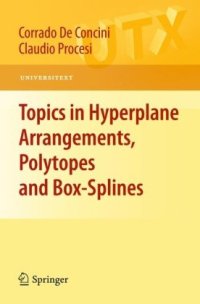
Ebook: Topics in hyperplane arrangements, polytopes and box-splines
- Tags: Linear and Multilinear Algebras Matrix Theory, Ordinary Differential Equations, Approximations and Expansions, Manifolds and Cell Complexes (incl. Diff.Topology), Topological Groups Lie Groups
- Series: Universitext
- Year: 2010
- Publisher: Springer-Verlag New York
- Edition: 1
- Language: English
- pdf
Several mathematical areas that have been developed independently over the last 30 years are brought together revolving around the computation of the number of integral points in suitable families of polytopes. The problem is formulated here in terms of partition functions and multivariate splines. In its simplest form, the problem is to compute the number of ways a given nonnegative integer can be expressed as the sum of h fixed positive integers. This goes back to ancient times and was investigated by Euler, Sylvester among others; in more recent times also in the higher dimensional case of vectors. The book treats several topics in a non-systematic way to show and compare a variety of approaches to the subject. No book on the material is available in the existing literature. Key topics and features include: - Numerical analysis treatments relating this problem to the theory of box splines - Study of regular functions on hyperplane and toric arrangements via D-modules - Residue formulae for partition functions and multivariate splines - Wonderful completion of the complement of hyperplane arrangements - Theory and properties of the Tutte polynomial of a matroid and of zonotopes Graduate students as well as researchers in algebra, combinatorics and numerical analysis, will benefit from Topics in Hyperplane Arrangements, Polytopes, and Box Splines.
Topics in Hyperplane Arrangements, Polytopes and Box-Splines brings together many areas of research that focus on methods to compute the number of integral points in suitable families or variable polytopes. The topics introduced expand upon differential and difference equations, approximation theory, cohomology, and module theory. This book, written by two distinguished authors, engages a broad audience by proving the a strong foudation. This book may be used in the classroom setting as well as a reference for researchers.